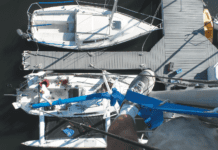While a haul out gives you opportunity for some repair, maintenance and upgrade work, it’s important to follow some winterizing procedures to avoid problems in the spring. Today’s tip focuses on your inboard engine and should be performed after your haul out.
Inboard Engines:
All salt water must be flushed from the engine. An easy method is to open the sea water strainer, remove the basket and put a garden hose into the bowl. Start the engine, and adjust the flow of fresh water. The seacock to the strainer must be closed to create suction. After operating temperature has been reached, run for an additional ten minutes.
With the engine running, remove the hose and pour antifreeze into the water strainer. When the exhaust becomes a consistent color, all the water has been displaced. Shut the engine down and top-up the strainer with antifreeze. Put the top back on the strainer and open the seacock.
A note on choosing antifreeze: Although eco-friendly propylene glycol (PG) is usually recommended because of its low toxicity, this chemical can harm neoprene, a material commonly used in valves, seals, and impellers. Ethylene glycol (EG), which PG was meant to replace, is kinder to these components, but users need to take care to handle and dispose of it properly. In any case, never use EG in potable water systems.
Change the engine oil and filter. Change the fuel filter if required. Inspect the gear box and replace oil if required. (Note: ALWAYS remove the foil seal on engine oil bottles COMPLETELY. Pushing it in like a flap increases the odds it will break loose and get poured into the valve cover.)
If the stuffing box is a dripless PYI type, loosen the collar and let the bellows expand, as per the instructions. Otherwise, inspect the traditional stuffing box packing for signs of wear on the shaft. Test the antifreeze in freshwater cooled engines. Inspect the water pump impeller, anti-siphon vents, and engine control cables – particularly the swivel ends. Inspect the cables, chains, and pulleys on pedestal steering systems, or else check the fluid in hydraulic steering systems. Inspect the packing gland on the rudder. Make certain all seacocks are sound.
For more important tips on the maintenance of your engine, purchase Beth Leonard’s The Voyager’s Handbook, 2nd editiontoday!






































